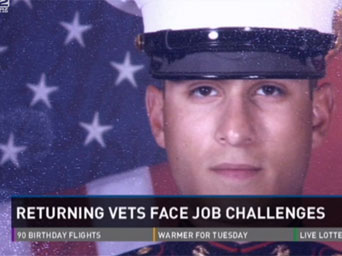Hope and Change is more than a campaign slogan for many service members and their families as they prepare to transition from active duty to civilian life in 2015.
As the Army continues to reduce its troop strength (otherwise known as downsize), transitioning service members and their families are holding on to the prospect of getting a viable job in light of the declining veteran unemployment rate.
Active duty service members are more confident their skills will translate to civilian jobs (81%, nearly twice more than in 2013).
But their confidence may be anchored in false hope.

A new University of Phoenix national military survey suggests that despite the declining veteran unemployment rate, many vets may actually be underemployed. It found that 61% of past service members who have held civilian jobs say they have previously been or currently are in jobs beneath their skill sets, many (72%) because they were unemployed and needed a job.
I recently spoke to U.S. Army Colonel (ret.) and University of Phoenix Military Division Associate Regional Vice President Garland Williams, who himself made a successful transition from a 28-year military career to civilian employment five years ago. My goal was to reveal some tactical and practical steps Veterans can make in 2015 to give meaning to hope and improve the chances of landing a job that pays the bills.
What he and the study revealed was enlightening.
First off, only one-third (34%) of veterans made a transition plan for returning to civilian life after separation from the military (just one percentage up from last year). Not good. The first fix:
- Make an action plan.
- It isn’t enough to just hope your skills will translate to any job. Identify the industries you want to work based on your skillset, then identify the companies.
- Once you identify the companies, look for a fellow Veteran that is employed in the company and make a connection – the best tool for this is LinkedIn.
- If you are able to make a connection, ask for guidance on how best to position your skills with HR. Granted, the HR process may be a “rats nest” but with an inside connection, you stand a better chance.
- Finally, plan your follow-up. Don’t just send your resume and let “fate” do the rest. Determine dates you will follow-up on what you send – until you are hired, your job is getting a job. Follow-up shows your commitment and tenacity.
Colonel Williams also shared that, according to the study, less than one-third (29%) of veterans say they are using their military skills in the civilian workplace. Not super shocking since many are underemployed.
Bottom line: The job market is competitive and if you don’t plan your mission targets, you stand a strong chance of under-utilizing those skills you acquired while in service. Plan your mission!
Next week, I’ll share the details of the next tactical step: the importance of a support network and how to leverage it.

The Military Wire, hosted by Mike Schindler, interviews some of America’s most elite men and women who have served this country in hopes that you the listener will gain an “ah-ha” moment that will help you move your life forward.
Mike is a US Navy Veteran, an award-winning author, and has been featured on Yahoo Finance, the Boston Globe, NY Post, USA Today, Q13 Fox, and numerous other media outlets discussing why today’s Veterans are truly one of America’s Greatest Assets. Mike is the author of two highly endorsed books, “Operation Military Family: How Military Couples are Fighting to Preserve their Marriages,” and “U.S. Veterans in the Workforce: Why the 7% are America’s Greatest Asset.”
All content herein is owned by author exclusively. Expressed opinions are NOT necessarily the views of VNR, authors, affiliates, advertisers, sponsors, partners, technicians, or VT Network. Some content may be satirical in nature.
All images within are full responsibility of the author and NOT VNR.
Read Full Policy Notice - Comment Policy





























